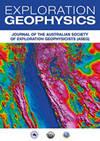Application research of comprehensive geophysical prospecting in a typical slope of abandoned open-pit in Beijing, China
IF 0.8
4区 地球科学
Q4 GEOCHEMISTRY & GEOPHYSICS
引用次数: 0
Abstract
AbstractNew government policy in China has facilitated research on the hazards in open-pit mine slopes. Remote sensing, geological, geophysical, and computer simulation techniques have been applied to obtain better information in slope investigation. In this study, we investigated the slope of the Qianlingshan open-pit mine area in Beijing, China. Electrical resistivity tomography and ground-penetrating radar were used, and the results were compared with borehole data to ascertain the slope structure, potential slip surface, and deformation zone. A geological model of the slope was established, and the slope stability was analyzed by numerical simulation. The results showed that the slope had an unstable surface layer over bedrock, and probable creep sliding-tension deformation. In addition, the slope would become less stable in wet conditions. The geological methods used in this study will provide a useful reference for further slope stability analysis and prevention.We took the Qianlingshan open-pit slope in Beijing, China, as the research object, by comprehensive application of historical remote sensing images analysis, field investigation, electrical resistivity tomography (ERT) and ground penetrating radar (GPR), and comparative analysis with borehole data, to obtain the slope parameter such as resistivity and velocity of electromagnetic wave, and to ascertain the slope structure, potential slip surface and deformation zone. On this basis, the geological generalisation model of slope was established, and the failure mechanism and stability of slope were analyzed by numerical simulation.KEYWORDS: Abandoned mineoverburden-bedrock slopegeological investigationselectrical resistivity tomography (ERT)ground penetrating radar (GPR)failure mechanism analysis AcknowledgementsWe would like to acknowledge Chunyu Liu and his team from China Coal Geology Group Company Limited for their invaluable assistance in the field work. We are also grateful to Prof. Chao Shen and Dr. Xin Huang for their comments that helped to improve the first version of paper.Disclosure statementNo potential conflict of interest was reported by the authors.Additional informationFundingThis study was supported by the Fundamental Research Funds for the Central Universities (grant number ZY20215125) and the Fund from the Key Laboratory of Active Tectonics and Geological Safety of Ministry of Natural Resources (grant number 20201203).综合物探在北京某典型废弃露天矿边坡中的应用研究
摘要中国政府的新政策促进了露天矿边坡危害的研究。遥感、地质、地球物理和计算机模拟等技术在边坡调查中得到了较好的应用。在本研究中,我们对北京千灵山露天矿区的边坡进行了调查。利用电阻率层析成像技术和探地雷达技术,与钻孔资料进行对比,确定边坡结构、潜在滑动面和变形带。建立了该边坡的地质模型,并对其稳定性进行了数值模拟分析。结果表明,该边坡基岩上有一不稳定的表面层,可能存在蠕变滑移-张拉变形。此外,在潮湿的条件下,边坡会变得不那么稳定。本文所采用的地质方法将为进一步的边坡稳定性分析和防治提供有益的参考。以北京千灵山露天矿边坡为研究对象,综合应用历史遥感影像分析、野外调查、电阻率层析成像(ERT)和探地雷达(GPR)等方法,并与钻孔资料对比分析,获得了边坡的电磁波电阻率、速度等参数,确定了边坡结构、潜在滑面和变形带。在此基础上,建立了边坡的地质概化模型,并通过数值模拟分析了边坡的破坏机理和稳定性。关键词:废弃矿山覆岩边坡地质调查电阻率层析成像探地雷达破坏机理分析感谢中煤地质集团有限公司刘春雨及其团队在野外工作中给予的宝贵帮助。我们也感谢沈超教授和黄鑫博士的意见,他们的意见有助于改进第一版论文。披露声明作者未报告潜在的利益冲突。本研究由中央高校基本科研业务费专项资金(批准号:ZY20215125)和自然资源部活动构造与地质安全重点实验室(批准号:20201203)资助。
本文章由计算机程序翻译,如有差异,请以英文原文为准。
求助全文
约1分钟内获得全文
求助全文
来源期刊

Exploration Geophysics
地学-地球化学与地球物理
CiteScore
2.30
自引率
0.00%
发文量
33
审稿时长
>12 weeks
期刊介绍:
Exploration Geophysics is published on behalf of the Australian Society of Exploration Geophysicists (ASEG), Society of Exploration Geophysics of Japan (SEGJ), and Korean Society of Earth and Exploration Geophysicists (KSEG).
The journal presents significant case histories, advances in data interpretation, and theoretical developments resulting from original research in exploration and applied geophysics. Papers that may have implications for field practice in Australia, even if they report work from other continents, will be welcome. ´Exploration and applied geophysics´ will be interpreted broadly by the editors, so that geotechnical and environmental studies are by no means precluded.
Papers are expected to be of a high standard. Exploration Geophysics uses an international pool of reviewers drawn from industry and academic authorities as selected by the editorial panel.
The journal provides a common meeting ground for geophysicists active in either field studies or basic research.
 求助内容:
求助内容: 应助结果提醒方式:
应助结果提醒方式:


